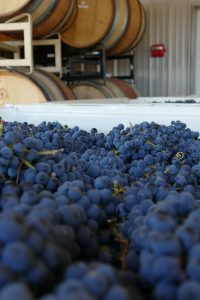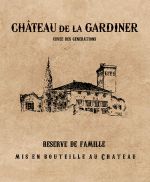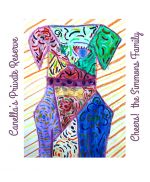
 TEMPRANILLO: A NOBLE GRAPE
TEMPRANILLO: A NOBLE GRAPE
There are a total of 17 noble grapes in the entire world. Nine of these are red. Tempranillo is one of them. I think that should evoke a pretty significant wow factor considering there are, more or less, some 10,000 varieties out there. In 2020 Tempranillo was the third most widely planted variety worldwide. Again…wow. And, who knew? Well, a reason for that may be that 97% is grown in Spain where it is the most planted red grape vine. Tempranillo is to Spain as Cabernet Sauvignon is to Bordeaux, as Sangiovese is to Italy. It is its signature wine and justly its claim to fame.
I tried to find Tempranillo’s history but it’s a little confusing. Is it really native to northern Spain? Then how did those scattered plantings get to southern Italy? And what have the Phoenicians got to do with it? The earliest official mention of it was in 1807. But it’s been around the Iberian peninsula since the ninth century BC, maybe before. Let’s just say it’s very old. As in ancient.
THE SKINNY ON STYLE
Similarly, some sources say this grape has thick skins and some say thin. Whaaat? I guess I’ll have to locate someone who is actually growing the grape to find out the skinny on this. What we do know is that it is a very dark colored grape and herein lies the source of the deep color of the wine. Because, as we recall, the skin of red, also referred to as black, grapes contain all those complex elements that not only result in the color of the wine along with tannins and those healthy antioxidants, but also anthrocyanins. These guys are a complex group of molecules also responsible for color. I’m guessing thick skins.
Tempranillo comes in a range of styles. Despite its deep color this wine can be a bit lighter and more elegant when it is grown at cooler, higher elevations. It can be somewhat similar to Pinot Noir with which it has often been compared. More commonly though, it ranges from medium to full bodied with moderate tannins and acidity. If grown in warmer climates, the variety can take on a darker fruit aspect with higher alcohol, higher tannins and lower acidity.
If you go to Spain and want Tempranillo, which of course you will, be prepared for the multitude of names this variety is called in different regions. For instance, it is called Cencibel in the vast central areas of Ribera del Guadiana and La Mancha, Tinto Fino in the more northern region of Ribera del Duero, Rioja in La Rioja (which is the renowned region that we will delve into in a bit) and Tinto de Toro for wines from the northwest area of Toro near Portugal. And if you happen to wander over the border into Portugal, it is called Aragonez and Tinto Roriz.
As you may recall, or not, Tinto Roriz is one of the varieties used in making port over there. Way over in Penedès on the northeast coast it has the interesting name of Ull de Llebre which translates into “eye of the hare.” I’m sure someone knows why…Oh, and throughout the entire country you may run into it under the names of Tempranilla or Tinto del Pais.
AGE MATTERS
Before we get into Rioja, let’s look at some particulars of this grape. First of all, the name comes from the Spanish word temprano, which means early. This is because Tempranillo not only buds early but also ripens two weeks earlier than most Spanish red grapes. This is important for areas with a short growing season. It thrives in chalky/clay soils and likes its weather warm by day and cool at night. It needs the warmth to develop its flavors and sugars but also the cool nights to retain acidity. High altitude in a continental climate is a preferred place. The best grapes come from vines that are at least twelve years old. Any younger and the roots are considered too superficial.
Age impacts the flavors of Tempranillo significantly. And a lot of these wines are aged longer than any other wines in the world. Much longer than actually required by law. In fact, a well made Tempranillo can age for over twenty years. The wine just hangs around in those dusty moldy caverns for as long as a winemaker sees fit. But these days, four to ten years is somewhat common. Interestingly, Tempranillo has a naturally low oxidizing enzyme that enables the wine to have exceptional longevity. It also has a more neutral aromatic profile so oak aging (and blending) helps in that department.
HOW IT’S MADE
Although increasingly Tempranillo is being made as a varietal, it is usually blended with other grapes. Garnacha (Grenache in France) is its most common partner contributing body, richness, acidity and texture. But others are Graziano, Mazuelo aka Carignan and even Cabernet Sauvignon and Merlot.
Long aging in oak barrels was French inspired. In 1780 a Rioja winemaker named Manuel Quintano adopted the Bordelaise method of aging wine and began successfully maturing his wine in wood. Unlike the French, however, Quintano used large barrels.
Later on, in the 1850’s and 60’s, after the phylloxera disaster in their own country, many French winemakers headed to Spain to start anew. Some started their own bodegas (wineries) and began the method of aging in oak but, instead of using large barrels, they used small casks which was the way of France. And just so, it became the norm. However. Spanish winemakers, being financially frugal in the tough times of the early nineteenth century, began importing American oak which was more economical. They crafted their own barrels. Really, just hired Spanish coopers to make their own. So, take that, you…Frenchmen.
Speaking of barrels, it is not only still common to use American oak, the norm is to use neutral, i.e. previously used, barrels for this wine. And to age the wine for a very long time. But this tradition is being challenged by younger and more modern winemakers who are increasingly using new French oak with less aging time. The practice of long aging in old American oak imparts particular flavors in traditional bottles considered to be “old style” especially from Rioja.
Ah, yes, Rioja. My first experience as a young and uneducated drinker of wine, let alone Spanish wine, was a gifted bottle of Rioja. And I loved it! So, while I don’t want to go into too much detail about all the wine regions of Spain, let us at least take a look at the one that made me aware of Spanish wine, the most renowned wine of Spain, Rioja.
WHERE AND WHY AND WHEN – DESIGNATIONS
Rioja is a region up in the northwest area of the country. These wines are mostly blends made with the Spanish natives Garnacha, Graciano, and Mazuelo with Tempranillo taking up the lion’s share in a bottle. These are the most reputable wines within Spain itself and are the most expensive and age worthy wines of Spain. They are classified in part by how long they age in oak but also by the quality of the grapes used. There are four classifications:
Vino Joven is the simplest, meant to be released right away and consumed when it is just 1 to 2 years old. These wines are light, fresh and fruity with no oak aging. If a label says Vino Joven or just “Rioja” you will know this is the kind of wine you are buying.
Crianza, meaning young, is usually the bread and butter of a winery. They are easy drinking wines with vibrant flavors and are generally made with grapes from good but not exceptional vineyards. The requirement for this designation is a total of 2 years of age, with one year of that in oak and another year in bottle.
Reservas are made with superior grapes from prime sites and are more lush and concentrated than crianzas. They tend to be subtle and supple but intense. Reservas are only made in exceptional years. The aging requirements are a total of 3 years, 1 in oak and 2 in bottle before being released.
Gran Reserva is the top category also only made in exceptional years. The grapes come from the very best vineyards. These are not common and represent just 1 to 10 percent of wines produced. But they are the most refined Riojas of all given the longest aging requirement in the oldest, most neutral barrels. By law they must be in barrel for 2 years and in bottle for at least 3 years. However, in reality, these wines are usually aged an average of 8 and a half years.
In general, Rioja wines are the most elegant of Spanish wines. Due to cooler temperatures and higher altitude they are lighter in style. Limestone soils lend them more mineral and acid. They are more floral and spicy and, of course, oak plays a huge part in their final development. As Karen MacNeil says in the Wine Bible, “Rioja is often referred to as Spain’s Bordeaux, despite the fact that its supple, earthy, often refined red wines have a delicacy more reminiscent of Burgundy.”
Another region of some renown is Ribera del Duero located a little south and west of La Rioja. It produces a richer style with riper red berry and tighter tannins.
Toro, in Castilla y León is typically deeper, darker and more brooding than Rioja with more blackberry fruit flavors and intense gripping tannins.
La Mancha and Ribera del Guadiana are the larger regions in the central plateau. You remember La Mancha with that skinny guy on a horse of no name. Yeah, hot and dry and existential here. But where the best value wines are produced so you don’t have to think about it.
Leaving this last hypnotic region of Spain, there are other areas where Tempranillo is grown, even if in tiny amounts. Remember, Spain produces 97% of this varietal worldwide! But there are some significant plantings in Portugal and also Argentina although I understand they are not so keen on it anymore. There’s Tempranillo in Australia, California around Monterey, southern Oregon, Washington state, and, Texas! Oh, also northern Mexico. I wanted to try some from Texas and Mexico but couldn’t get my hands on any. Darn.
WHAT TO EXPECT
Before I get into the bottles I did get my hands on, let’s talk about what to expect in terms of typical tastes and aromas of these wines. The younger wines are notably fresh with red fruits like cherry, strawberry and raspberry but still have savory notes like dried tomato, red pepper and something like “chalky.” After 20 years they soften and sweeten with nutty and dried fruit characteristics.
The traditional long aging in old neutral barrels made from American oak that we talked about earlier also imparts flavors of vanilla, coconut, sandalwood, butterscotch and dill. Look for these aromas and tastes and others like cedar, dried fig, dust, leather and tobacco in those older bottles. You will find complex layers of flavors in a good Tempranillo. And, although you can find these wines at a variety of price points, many of them quite good, some of the older more prestigious bottles will go for hundreds of dollars.
So…what did I try? Only four bottles, but they were all different! Here they are:
Bodegas Muga Reserva 2017
DOCa Rioja 14.5%abv $24.47
note: unfiltered
This reserva showed notes of spiced cherry, smoke and some fresh tobacco on the nose followed by a juicy palate of more spicy red fruit, cedar and chalky tannins. I caught a little dill right at the end. Good balance. I really liked this one and could drink it with or without food.
Enebral Tinta de Toro 2016
DO Toro 14.5%abv $16.99
note: 11 months in new French oak followed by 6 months in bottle
Bright ruby colored. As indicated in the note above this is more of a new world style from the Toro region with clean bright red fruit and a little spice. Notes of tomato and sour cherry. Very tasty, easy to drink, with a rather short finish.
Latitud 42 Gran Reserva 2010
DOCa Rioja 14.5%abv $29.99
note:15% Graciano
Lots of funk and earth and wood on the nose along with sweet dark plum and dried fruit. Moves into dusty, raisin, vanilla territory with some deep dark fruit and a little eucalyptus/minty thing happening on the palate. Stronger tannins here but well integrated. Definitely a more traditional older styled wine.
Camaraderie Cellars Tempranillo 2011
Yakima Valley, Washington 14.3%abv $27.99
note: a Washington wine!
This is a 2011and is one year younger than the Latitud 42 Gran Reserva above. It has a deep garnet color moving towards brick. Not so raisin-y this one. I know this is weird but both of these older wines make me think of meatloaf! Tomato, meaty, savory, with some very dark fruit involved. And vanilla. Pretty good!
Which brings me around to food pairings. Because of its savory qualities this wine purportedly goes with almost everything! Roasted chicken, beef short ribs, hamburgers, enchiladas, paella, roasted vegetables, pizza, grilled eggplant, corn based dishes. Bolder aged Tempranillo pairs nicely with steak or gourmet burgers and rack of lamb. Fresher styles do well with baked pasta and other tomato based dishes. Yeah, pretty much everything! So try it!
I hope you do try this type of wine if you haven’t already. It’s not for the jammy fruity minded but, who knows, it might be another style you’ll come to like. I appreciate its dry, savory, complex qualities. I’m going to find a bottle from Oregon. And then Texas!
Until then, giddy up, li’l wine drinker!
Respectfully,
Peg












0 Comments